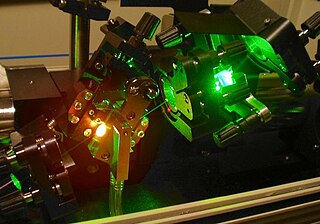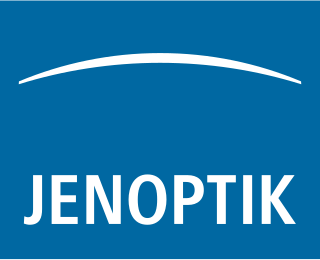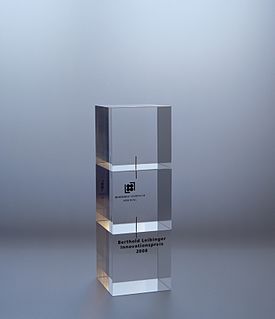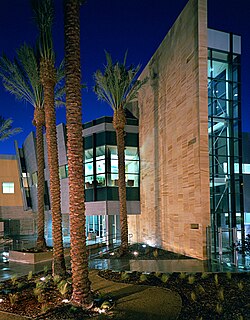
A laser is a device that emits light through a process of optical amplification based on the stimulated emission of electromagnetic radiation. The word "laser" is an acronym for "light amplification by stimulated emission of radiation". The first laser was built in 1960 by Theodore H. Maiman at Hughes Research Laboratories, based on theoretical work by Charles Hard Townes and Arthur Leonard Schawlow.
Mode locking is a technique in optics by which a laser can be made to produce pulses of light of extremely short duration, on the order of picoseconds (10−12 s) or femtoseconds (10−15 s). A laser operated in this way is sometimes referred to as a femtosecond laser, for example, in modern refractive surgery. The basis of the technique is to induce a fixed phase relationship between the longitudinal modes of the laser's resonant cavity. Constructive interference between these modes can cause the laser light to be produced as a train of pulses. The laser is then said to be "phase-locked" or "mode-locked".

Ti:sapphire lasers (also known as Ti:Al2O3 lasers, titanium-sapphire lasers, or Ti:sapphs) are tunable lasers which emit red and near-infrared light in the range from 650 to 1100 nanometers. These lasers are mainly used in scientific research because of their tunability and their ability to generate ultrashort pulses. Lasers based on Ti:sapphire were first constructed and invented in June 1982 by Peter Moulton at the MIT Lincoln Laboratory.
In optics, an ultrashort pulse, also known as an ultrafast event, is an electromagnetic pulse whose time duration is of the order of a picosecond or less. Such pulses have a broadband optical spectrum, and can be created by mode-locked oscillators. Amplification of ultrashort pulses almost always requires the technique of chirped pulse amplification, in order to avoid damage to the gain medium of the amplifier.

In physics, terahertz time-domain spectroscopy (THz-TDS) is a spectroscopic technique in which the properties of matter are probed with short pulses of terahertz radiation. The generation and detection scheme is sensitive to the sample's effect on both the amplitude and the phase of the terahertz radiation. By measuring in the time-domain, the technique can provide more information than conventional Fourier-transform spectroscopy, which is only sensitive to the amplitude.

Chirped pulse amplification (CPA) is a technique for amplifying an ultrashort laser pulse up to the petawatt level, with the laser pulse being stretched out temporally and spectrally, then amplified, and then compressed again. The stretching and compression uses devices that ensure that the different color components of the pulse travel different distances.

Jenoptik AG is a German integrated photonics group that divides its activities into three photonics-based divisions Light & Optics, Light & Production and Light & Safety.
Barry Martin Schuler is an American Internet entrepreneur and former chairman and CEO of America Online Inc. He is best known for leading the AOL team that simplified the online service provider's user interface, making it possible for millions of consumers to gain easy access to the Internet.
Picosecond ultrasonics is a type of ultrasonics that uses ultra-high frequency ultrasound generated by ultrashort light pulses. It is a non-destructive technique in which picosecond acoustic pulses penetrate into thin films or nanostructures to reveal internal features such as film thickness as well as cracks, delaminations and voids. It can also be used to probe liquids. The technique is also referred to as picosecond laser ultrasonics or laser picosecond acoustics.
An ultrashort pulse laser is a laser that emits ultrashort pulses of light, generally of the order of femtoseconds to one picosecond. They are also known as ultrafast lasers owing to the speed at which pulses "turn on" and "off"—not to be confused with the speed at which light propagates, which is determined by the properties of the medium, particularly its index of refraction, and can vary as a function of field intensity and wavelength.

The Berthold Leibinger Innovationspreis is an award for given to those who have created applied laser technology and innovations on the application or generation of laser light. It is open to participants worldwide. It is biennially awarded by the German non-profit foundation Berthold Leibinger Stiftung. Three prizes are awarded worth 100,000 euros. The prize winners are selected from eight finalists that present their work person in a jury session. The jury is composed of international experts from different fields.
EKSPLA is a laser manufacturing company based in Lithuania. EKSPLA is known for their lasers and laser systems as well as other photonics components. The company is supplying their products for scientific, OEM & industrial applications.

Cymer, LLC., an ASML Holding company, is an American company headquartered in San Diego, California. Cymer is the largest supplier of deep ultraviolet (DUV) light sources used by chipmakers to pattern advanced semiconductor chips or integrated circuits.
Electro Scientific Industries, Inc. (ESI) is an American high technology company headquartered in the Portland, Oregon metropolitan area, specifically in Beaverton, Oregon, since 2021, but from 1963–2021 it was based in the unincorporated Cedar Mill area just north of Beaverton. ESI is a developer and supplier of photonic and laser systems for microelectronics manufacturers. Founded in 1944, it is the oldest high-tech company in Oregon. Along with Tektronix, and later Intel, it has spawned numerous technology-based companies in the Portland area, an area known as the Silicon Forest. From 1983 to 2019, shares in the company were publicly traded on NASDAQ, under the ticker symbol ESIO.
Ultrafast x-rays or ultrashort X-ray pulses are femtosecond x-ray pulses with wavelengths occurring at interatomic distances. This beam uses the X-ray's inherent abilities to interact at the level of atomic nuclei and core electrons. This ability combined with the shorter pulses at 30 femtosecond could capture the change in position of atoms, or molecules during phase transitions, chemical reactions, and other transient processes in physics, chemistry, and biology.
Thorlabs, Inc. is an American privately held optical equipment company headquartered in Newton, New Jersey. The company was founded in 1989 by Alex Cable, who serves as its current president and CEO. As of 2018, Thorlabs has annual sales of approximately $500 million. Outside its multiple locations in the United States, the company has offices in Brazil, Canada, China, France, Germany, Japan, Sweden, and the United Kingdom. It sells approximately 20,000 different products.
NeoPhotonics Corporation is an American public corporation based in San Jose, California. It was founded in 1996. The company develops, manufactures and sells optoelectronic products that transmit, receive and switch high speed digital optical signals for communications networks, These products include transceivers, tunable lasers, high bandwidth receivers, optical semiconductors, photonic integrated circuits, and 100 gigabit per second and above modules." These are each "cost-effective components that handle massive amounts of data at very high speeds".
High Harmonic Generation (HHG) is a non-perturbative and extremely nonlinear optical process taking place when a highly intense ultrashort laser pulse undergoes an interaction with a nonlinear media. A typical high order harmonic spectra contains frequency combs separated by twice the laser frequency. HHG is an excellent table top source of highly coherent extreme ultraviolet and soft X-ray laser pulses.
II-VI Incorporated is an American manufacturer of optical materials and semiconductors. As of 2021, the company had 22,961 employees. Their stock is listed at Nasdaq under the ticker symbol IIVI. The company's name is pronounced "Two Six Incorporated".
Coherent, Inc. is a public company headquartered in Santa Clara, California. It manufactures and supports laser equipment and components. The company was founded in May 1966 by physicist James Hobart and five cofounders. It went public in 1970. Over time, Coherent acquired other laser businesses and expanded to lasers for different industries and applications. From 2004 to 2021, it grew from $400 million to almost $2 billion in revenues, in part through a series of acquisitions.






